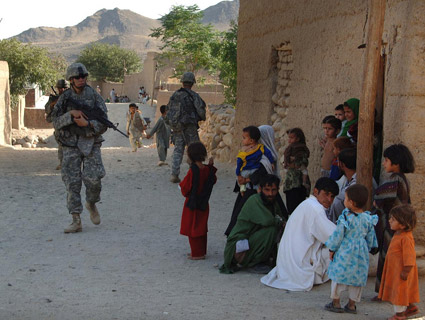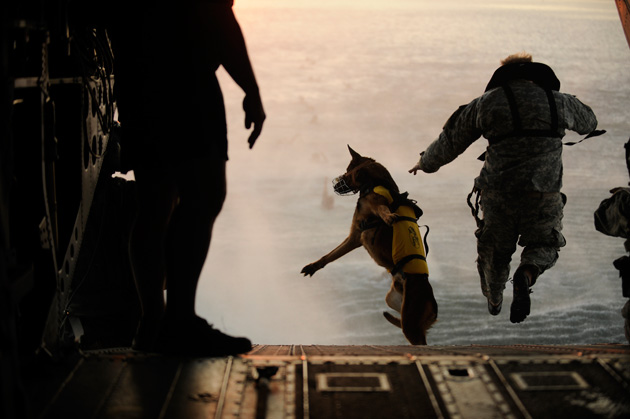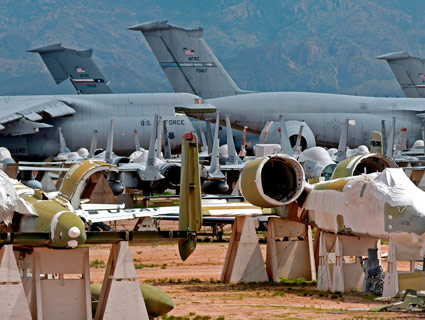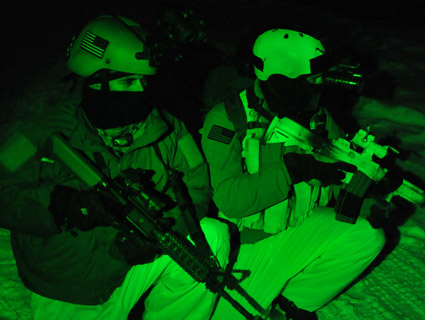
US Army soldiers conduct a patrol through the village of Kowtalay in the Nuristan province of Afghanistan.<a href="http://www.flickr.com/photos/soldiersmediacenter/768980804/">Michael Bracken/US Army</a>/Flickr
![]() This story first appeared on the TomDispatch website.
This story first appeared on the TomDispatch website.
It’s a story that should take your breath away: the destabilization of what, in the Bush years, used to be called “the arc of instability.” It involves at least 97 countries, across the bulk of the global south, much of it coinciding with the oil heartlands of the planet. A startling number of these nations are now in turmoil, and in every single one of them—from Afghanistan and Algeria to Yemen and Zambia —Washington is militarily involved, overtly or covertly, in outright war or what passes for peace.
Garrisoning the planet is just part of it. The Pentagon and US intelligence services are also running covert special forces and spy operations, launching drone attacks, building bases and secret prisons, training, arming, and funding local security forces, and engaging in a host of other militarized activities right up to full-scale war. But while you consider this, keep one fact in mind: the odds are that there is no longer a single nation in the arc of instability in which the United States is in no way militarily involved.
Covenant of the Arc
“Freedom is on the march in the broader Middle East,” the president said in his speech. “The hope of liberty now reaches from Kabul to Baghdad to Beirut and beyond. Slowly but surely, we’re helping to transform the broader Middle East from an arc of instability into an arc of freedom.”
An arc of freedom. You could be forgiven if you thought that this was an excerpt from President Barack Obama’s Arab Spring speech, where he said “[I]t will be the policy of the United States to… support transitions to democracy.” Those were, however, the words of his predecessor George W. Bush. The giveaway is that phrase “arc of instability,” a core rhetorical concept of the former president’s global vision and that of his neoconservative supporters.
The dream of the Bush years was to militarily dominate that arc, which largely coincided with the area from North Africa to the Chinese border, also known as the Greater Middle East, but sometimes was said to stretch from Latin America to Southeast Asia. While the phrase has been dropped in the Obama years, when it comes to projecting military power President Obama is in the process of trumping his predecessor.
In addition to waging more wars in “arc” nations, Obama has overseen the deployment of greater numbers of special operations forces to the region, has transferred or brokered the sale of substantial quantities of weapons there, while continuing to build and expand military bases at a torrid rate, as well as training and supplying large numbers of indigenous forces. Pentagon documents and open source information indicate that there is not a single country in that arc in which US military and intelligence agencies are not now active. This raises questions about just how crucial the American role has been in the region’s increasing volatility and destabilization.
Flooding the Arc
Given the centrality of the arc of instability to Bush administration thinking, it was hardly surprising that it launched wars in Afghanistan and Iraq, and carried out limited strikes in three other arc states—Yemen, Pakistan, and Somalia. Nor should anyone have been shocked that it also deployed elite military forces and special operators from the Central Intelligence Agency elsewhere within the arc.
In his book The One Percent Doctrine, journalist Ron Suskind reported on CIA plans, unveiled in September 2001 and known as the “Worldwide Attack Matrix,” for “detailed operations against terrorists in 80 countries.” At about the same time, then-Secretary of Defense Donald Rumsfeld proclaimed that the nation had embarked on “a large multi-headed effort that probably spans 60 countries.” By the end of the Bush years, the Pentagon would indeed have special operations forces deployed in 60 countries around the world.
It has been the Obama administration, however, that has embraced the concept far more fully and engaged the region even more broadly. Last year, the Washington Post reported that US had deployed special operations forces in 75 countries, from South America to Central Asia. Recently, however, US Special Operations Command spokesman Colonel Tim Nye told me that on any given day, America’s elite troops are working in about 70 countries, and that its country total by year’s end would be around 120. These forces are engaged in a host of missions, from Army Rangers involved in conventional combat in Afghanistan to the team of Navy SEALs who assassinated Osama bin Laden in Pakistan, to trainers from the Army, Navy, Air Force, and Marines within US Special Operations Command working globally from the Dominican Republic to Yemen.
The United States is now involved in wars in six arc-of-instability nations: Afghanistan, Iraq, Libya, Pakistan, Somalia, and Yemen. It has military personnel deployed in other arc states, including Algeria, Bahrain, Djibouti, Egypt, Israel, Jordan, Kuwait, Lebanon, Morocco, Oman, Pakistan, Qatar, Saudi Arabia, Tunisia, and the United Arab Emirates. Of these countries, Afghanistan, Bahrain, Djibouti, Iraq, Kuwait, Oman, Qatar, Saudi Arabia, and the United Arab Emirates all host US military bases, while the CIA is reportedly building a secret base somewhere in the region for use in its expanded drone wars in Yemen and Somalia. It is also using already existing facilities in Djibouti, Ethiopia, and the United Arab Emirates for the same purposes, and operating a clandestine base in Somalia where it runs indigenous agents and carries out counterterrorism training for local partners.
In addition to its own military efforts, the Obama administration has also arranged for the sale of weaponry to regimes in arc states across the Middle East, including Bahrain, Egypt, Iraq, Jordan, Kuwait, Morocco, Saudi Arabia, Tunisia, the United Arab Emirates, and Yemen. It has been indoctrinating and schooling indigenous military partners through the State Department’s and Pentagon’s International Military Education and Training program. Last year, it provided training to more than 7,000 students from 130 countries. “The emphasis is on the Middle East and Africa because we know that terrorism will grow, and we know that vulnerable countries are the most targeted,” Kay Judkins, the program’s policy manager, recently told the American Forces Press Service.
According to Pentagon documents released earlier this year, the US has personnel—some in token numbers, some in more sizeable contingents—deployed in 76 other nations sometimes counted in the arc of instability: Angola, Botswana, Burundi, Cameroon, Chad, Congo, Cote d’Ivoire, Ethiopia, Gabon, Ghana, Guinea, Kenya, Liberia, Madagascar, Mali, Mauritania, Mozambique, Niger, Nigeria, Rwanda, Senegal, Sierra Leone, South Africa, Sudan, Tanzania, Togo, Uganda, Zambia, Zimbabwe, Sri Lanka, Syria, Antigua, the Bahamas, Barbados, Belize, Bolivia, Colombia, Costa Rica, Cuba, the Dominican Republic, Ecuador, El Salvador, Guatemala, Guyana, Haiti, Honduras, Jamaica, Mexico, Nicaragua, Panama, Paraguay, Peru, Suriname, Trinidad and Tobago, Uruguay, Venezuela, Albania, Bosnia and Herzegovina, Macedonia, Romania, Serbia, Kazakhstan, Kyrgyzstan, Tajikistan, Turkmenistan, Uzbekistan, Bangladesh, Myanmar, Cambodia, Indonesia, Laos, Malaysia, the Philippines, Singapore, Thailand, and Vietnam.
While arrests of 30 members of an alleged CIA spy ring in Iran earlier this year may be, like earlier incarcerations of supposed American “spies”, pure theater for internal consumption or international bargaining, there is little doubt that the US is conducting covert operations there, too. Last year, reports surfaced that US black ops teams had been authorized to run missions inside that country, and spies and local proxies are almost certainly at work there as well. Just recently, the Wall Street Journal revealed a series of “secret operations on the Iran-Iraq border” by the US military and a coming CIA campaign of covert operations aimed at halting the smuggling of Iranian arms into Iraq.
All of this suggests that there may, in fact, not be a single nation within the arc of instability, however defined, in which the United States is without a base or military or intelligence personnel, or where it is not running agents, sending weapons, conducting covert operations—or at war.
The Arc of History
Just after President Obama came into office in 2009, then-Director of National Intelligence Dennis Blair briefed the Senate Select Committee on Intelligence. Drawing special attention to the arc of instability, he summed up the global situation this way: “The large region from the Middle East to South Asia is the locus for many of the challenges facing the United States in the twenty-first century.” Since then, as with the Bush-identified phrase “global war on terror,” the Obama administration and the US military have largely avoided using “arc of instability,” preferring to refer to it using far vaguer formulations.
 During a speech at the National Defense Industrial Association’s annual Special Operations and Low-Intensity Conflict Symposium earlier this year, for example, Navy Admiral Eric Olson, then the chief of US Special Operations Command, pointed toward a composite satellite image of the world at night. Before September 11, 2001, said Olson, the lit portion of the planet—the industrialized nations of the global north—were considered the key areas. Since then, he told the audience, 51 countries, almost all of them in the arc of instability, have taken precedence. “Our strategic focus,” he said, “has shifted largely to the south… certainly within the special operations community, as we deal with the emerging threats from the places where the lights aren’t.”
During a speech at the National Defense Industrial Association’s annual Special Operations and Low-Intensity Conflict Symposium earlier this year, for example, Navy Admiral Eric Olson, then the chief of US Special Operations Command, pointed toward a composite satellite image of the world at night. Before September 11, 2001, said Olson, the lit portion of the planet—the industrialized nations of the global north—were considered the key areas. Since then, he told the audience, 51 countries, almost all of them in the arc of instability, have taken precedence. “Our strategic focus,” he said, “has shifted largely to the south… certainly within the special operations community, as we deal with the emerging threats from the places where the lights aren’t.”
More recently, in remarks at the Paul H. Nitze School of Advanced International Studies in Washington, D.C., John O. Brennan, the assistant to the president for homeland security and counterterrorism, outlined the president’s new National Strategy for Counterterrorism, which highlighted carrying out missions in the “Pakistan-Afghanistan region” and “a focus on specific regions, including what we might call the periphery—places like Yemen, Somalia, Iraq, and the Maghreb [northern Africa].”
“This does not,” Brennan insisted, “require a ‘global’ war”—and indeed, despite the Bush-era terminology, it never has. While, for instance, planning for the 9/11 attacks took place in Germany and would-be shoe-bomber Richard Reid hailed from the United Kingdom, advanced, majority-white Western nations have never been American targets. The “arc” has never arced out of the global south, whose countries are assumed to be fundamentally unstable by nature and their problems fixable through military intervention.
Building Instability
A decade’s evidence has made it clear that US operations in the arc of instability are destabilizing. For years, to take one example, Washington has wielded military aid, military actions, and diplomatic pressure in such a way as to undermine the government of Pakistan, promote factionalism within its military and intelligence services, and stoke anti-American sentiment to remarkable levels among the country’s population. (According to a recent survey, just 12 percent of Pakistanis have a positive view of the United States.)
A semi-secret drone war in that nation’s tribal borderlands, involving hundreds of missile strikes and significant, if unknown levels, of civilian casualties, has been only the most polarizing of Washington’s many ham-handed efforts. When it comes to that CIA-run effort, a recent Pew survey of Pakistanis found that 97 percent of respondents viewed it negatively, a figure almost impossible to achieve in any sort of polling.
In Yemen, long-time support—in the form of aid, military training, and weapons, as well as periodic air or drone strikes—for dictator Ali Abdullah Saleh led to a special relationship between the US and elite Yemeni forces led by Saleh’s relatives. This year, those units have been instrumental in cracking down on the freedom struggle there, killing protesters and arresting dissenting officers who refused orders to open fire on civilians. It’s hardly surprising that, even before Yemen slid into a leaderless void (after Saleh was wounded in an assassination attempt), a survey of Yemenis found—again a jaw-dropping polling figure—99 percent of respondents viewed the US government’s relations with the Islamic world unfavorably, while just 4 percent “somewhat” or “strongly approved” of Saleh’s cooperation with Washington.
Instead of pulling back from operations in Yemen, however, the US has doubled down. The CIA, with support from Saudi Arabia’s intelligence service, has been running local agents as well as a lethal drone campaign aimed at Islamic militants. The US military has been carrying out its own air strikes, as well as sending in more trainers to work with indigenous forces, while American black ops teams launch lethal missions, often alongside Yemeni allies.
These efforts have set the stage for further ill-will, political instability, and possible blowback. Just last year, a US drone strike accidentally killed Jabr al-Shabwani, the son of strongman Sheikh Ali al-Shabwani. In an act of revenge, Ali repeatedly attacked of one of Yemen’s largest oil pipelines, resulting in billions of dollars in lost revenue for the Yemeni government, and demanded Saleh stop cooperating with the US strikes.
Earlier this year, in Egypt and Tunisia, long-time US efforts to promote what it liked to call “regional stability”—through military alliances, aid, training, and weaponry—collapsed in the face of popular movements against the US-supported dictators ruling those nations. Similarly, in Bahrain, Iraq, Jordan, Kuwait, Morocco, Oman, Saudi Arabia, and the United Arab Emirates, popular protests erupted against authoritarian regimes partnered with and armed courtesy of the US military. It’s hardly surprising that, when asked in a recent survey whether President Obama had met the expectations created by his 2009 speech in Cairo, where he called for “a new beginning between the United States and Muslims around the world,” only 4 percent of Egyptians answered yes. (The same poll found only 6 percent of Jordanians thought so and just 1 percent of Lebanese.)
A recent Zogby poll of respondents in six Arab countries—Egypt, Jordan, Lebanon, Morocco, Saudi Arabia, and the United Arab Emirates—found that, taking over from a president who had propelled anti-Americanism in the Muslim world to an all-time high, Obama managed to drive such attitudes even higher. Substantial majorities of Arabs in every country now view the US as not contributing “to peace and stability in the Arab World.”
Increasing Instability Across the Globe
US interference in the arc of instability is certainly nothing new. Leaving aside current wars, over the last century, the United States has engaged in military interventions in the global south in Cambodia, Congo, Cuba, the Dominican Republic, El Salvador, Egypt, Grenada, Guatemala, Haiti, Honduras, Iraq, Kuwait, Laos, Lebanon, Libya, Panama, the Philippines, Mexico, Nicaragua, Panama, Somalia, Thailand, and Vietnam, among other places. The CIA has waged covert campaigns in many of the same countries, as well as Afghanistan, Algeria, Chile, Ecuador, Indonesia, Iran, and Syria, to name just a few.
Like George W. Bush before him, Barack Obama evidently looks out on the “unlit world” and sees a source of global volatility and danger for the United States. His answer has been to deploy US military might to blunt instability, shore up allies, and protect American lives.
Despite the salient lesson of 9/11– interventions abroad beget blowback at home—he has waged wars in response to blowback that have, in turn, generated more of the same. A recent Rasmussen poll indicates that most Americans differ with the president when it comes to his idea of how the US should be involved abroad. Seventy-five percent of voters, for example, agreed with this proposition in a recent poll: “The United States should not commit its forces to military action overseas unless the cause is vital to our national interest.” In addition, clear majorities of Americans are against defending Afghanistan, Iraq, Pakistan, Saudi Arabia, and a host of other arc of instability countries, even if they are attacked by outside powers.
After decades of overt and covert US interventions in arc states, including the last 10 years of constant warfare, most are still poor, underdeveloped, and seemingly even more unstable. This year, in their annual failed state index—a ranking of the most volatile nations on the planet—Foreign Policy and the Fund for Peace placed the two arc nations that have seen the largest military interventions by the US—Iraq and Afghanistan—in their top ten. Pakistan and Yemen ranked 12th and 13th, respectively, while Somalia—the site of US interventions under President Bill Clinton in the 1990s, during the Bush presidency in the 2000s, and again under Obama—had the dubious honor of being number one.
For all the discussions here about (armed) “nation-building efforts” in the region, what we’ve clearly witnessed is a decade of nation unbuilding that ended only when the peoples of various Arab lands took their futures into their own hands and their bodies out into the streets. As recent polling in arc nations indicates, people of the global south see the United States as promoting or sustaining, not preventing, instability, and objective measures bear out their claims. The fact that numerous popular uprisings opposing authoritarian rulers allied with the US have proliferated this year provides the strongest evidence yet of that.
With Americans balking at defending arc-of-instability nations, with clear indications that military interventions don’t promote stability, and with a budget crisis of epic proportions at home, it remains to be seen what pretexts the Obama administration will rely on to continue a failed policy—one that seems certain to make the world more volatile and put American citizens at greater risk.
Nick Turse is a historian, investigative journalist, the associate editor of TomDispatch.com, and a senior editor at Alternet.org. His latest book is The Case for Withdrawal from Afghanistan (Verso Books). You can follow him on Twitter @NickTurse, on Tumblr, and on Facebook. This article is a collaboration between Alternet.org and TomDispatch.com. To stay on top of important articles like these, sign up to receive the latest updates from TomDispatch.com here.














